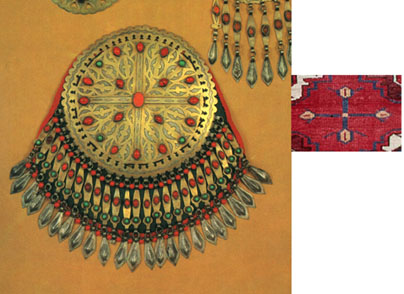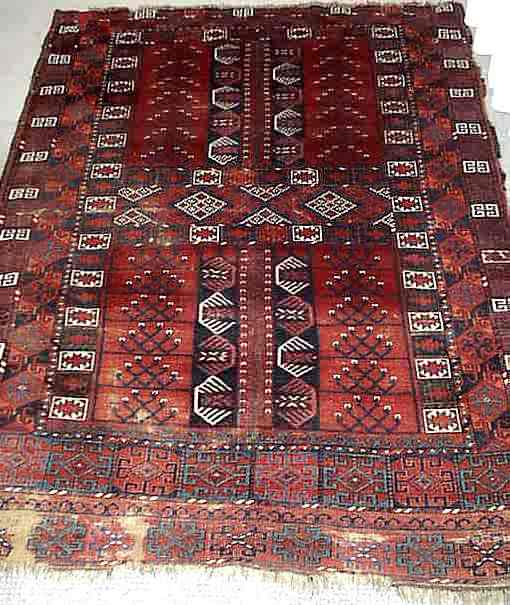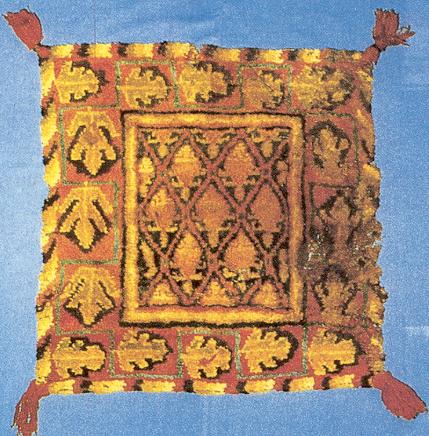
Regards, Yon
On the prehistoric origin of rug motifs
The idea that rug motifs can be traced back thousands of years
is hardly a new one. Cassin and Hoffmeister in "Tent Band - Tent Bag" champion this idea, as did Elena
Tsareva in a recent U.S. lecture tour (you can read a summary of her New England Rug Society talk on page 2 of
the November 6, 2001 Newsletter, accessible at http://www.ne-rugsociety.org/newslett.htm
). still, I remained somewhat skeptical about these theories until, a few weeks ago, I chanced on an article in
the Pennsylvania Gazette (my alumni magazine) issue of Nov/Dec 2001. The article, by Samuel Hughes is entitled
'The Stamp Seal Mystery' and it can be read at http://www.upenn.edu/gazette/1101/hughes.html . The article discusses a small stamping seal, about 1 inch square in size, that
was found on the ground near a 4300 years old stratum in the excavations at Anau, Turkmenistan. This seal has raised
many questions: Is it really that old? (it wasn't found actually in the excavation.) Do its symbols belong to an
ancient proto-Chinese script, much older than had been suspected to exist? For a thorough discussion of these questions
you'll have to read the article. For me, however, as a ruggie who had just heard Tsareva's talk, the seal only
meant one thing: All its symbols are clearly ones that we find abundantly today on Turkmen rugs, as well as on
many others. I immediately took out the digital camera and photographed the same motifs as they appear on various
pieces in my collection, and with the help of Photoshop arranged them into a montage to mimic the seal. The results
appear below: the seal on the left, my montage on the right. While the 'S' motif may have changed somewhat, the
others are almost identical in the two pictures. Of course, none of this proves anything, but I'd say it's strongly
suggestive!

Regards, Yon
Wow - that is amazing. How I wish that textiles weren't so perishable!
Thank you, Jon.
Hi Yon,
The "S" form is seen often in Caucasian stuff with a morphology very much like that of the seal.
Such similarities are in the category of anecdotal evidence, of course, but very provocative.
Regards,
Steve Price
Yon -
Your finding is interesting to me because I have spent a little time now looking for designs used in Central Asian
weavings in other items with designs (e.g., architecture, decorations on buildings, on pottery, etc. I'm sure I'm
wrong but I have been able to recognize very few designs in these other settings that seem also to occur in the
weavings. That has both surprised me and also seemed likely not quite accurate.
I bought a book a couple of years ago on Uzbek painted ceiling decorations. It did not seem to me that there was
much in these very elaborate, colorful ceilings that resembled any designs I was seeing in the weavings. If I can
dig out the "ceiling" book, I will post some images for us to look at.
So your little piece is interesting to me as a departure from what is likely my limited experience.
Regards,
R. John Howe
Menu
Yon,
I hate to disappoint you, but the "stamp-seal" you show is just the menu cover for a Turkmen restaurant.
The "S" means "Seating is Available", the "8" means "Table for Eight",
the tridents imply "seafood is on the menu" and the forked line to the right means "knives and forks
are available" for the patrons.
Hungrily yours,
Patrick Weiler
Dear Yon,
I read Tsareva’s lecture. Was she actually suggesting that the people who left the engravings and the ceramics
fragments in South Turkmenistan from the sixth millennium BC where Turkmen? Peoples passed by, migrated from the
central Asian steppes towards Europe, but they stopped there. And they are still there. How interesting. If it
is so, they are remarkably stationary nomads!
Regards,
Filiberto
Filiberto, Tsareva certainly did not imply that the people living
in Turkmenistan 4300 years ago were Turkmen. You seem to be confusing two types of nomadism: migratory and pastoral.
I am sure you know that the many Turkic tribes migrated from easter Asia westwards starting in the middle of the
first millenium. On the way, some of them 'settled' in many places along the route, mingling with the local populations
and conferring their language on them almost everywhere but also absorbing much of the local culture. Many of these
now 'stationary' tribes retained the pastoral-nomadism way of life, i.e., they continued to move between summer
and winter pasturages within a more or less stable region, though perhaps migrating to different pastures under
ecological and military pressures. Thus there is no contradiction at all in finding pastoral-nomadic Turkmen tribes
who have been in Turkmenistan, say, 500-1000 years but using symbols inherited from earlier populations in the
region. That is Tsareva's point.
Regards, Yon
Lack of parallels in other genres
John, I too had a hard time finding good examples of, say, Turkmen
rugs having common motifs with other art genres. This is perhaps not surprising; the average Turkmen woman has
probably never seen the inside of a building, and her husband is unlikely to come home from his slave-selling expedition
to Bokhara and sketch out for his wife a design that he saw in town for her to weave. The one genre where I expect
to find common motifs is jewelry, since basically the same sets of people made both (even my wife makes both quilts
and jewelry!) Of course we find depictions of entire pieces of jewelry on rugs (notably asmalyks), but there are
also common motifs. See, for example the illustration below. On the left is a piece of jewelry with a cross (Sophia,
please note!) in its center, and on the right is a secondary gul from a Yomud chuval.

As usual, this proves nothing.
Regards, Yon
Note: the jewel comes from a book called 'Turkmen Folk Art,' Ashkabad, 1990.
Hi Yon,
I am aware of the two types of nomadism: just tried to make a joke. ![]()
I re-read the article. From how it is written it just seems the way I thought. See second column, page 2: from
"They were a European-type people" to "the spindle was one of the most important items in Turkmen
history" there is nothing to suggest she is speaking of two different populations, the indigenous one and
the Turkmen.
Perhaps an imprecision of the writer.
He made another imprecision anyway, when he writes of "rock engravings, both from south Turkmenistan from the sixth millenium BC."
That makes 8000 years of development, so I guess it should be "the fourth millenium BC".
Thanks for your clarification.
Regards,
Filiberto
Filiberto, you are right, the text is misleading. Many references
to 'Turkmen people' should have been something like 'the people of the area that's present day Turkmenistan.' Mea
culpa - as Editor I should have caught it.
Regards, Yon
Dear Yon,
Never mind, I forgive you - even for your doubts about Marco Polo. ![]()
![]()
![]()
Filiberto
Hi all,
As we've drifted into the Turkoman arena in this
thread, I'd like to draw your attention to a
design element that has interested me for a while,
which is present along the sides of the central
spine of many ensis that I've seen. Described
variably as a leaf, a flower, or an almond, it
takes on several styles. Some are rigidly
geometric, some with curved edges.
(Maybe Steve can help with the images referenced
here; hint...) Done - that's why I get the Big Bucks,
Chuck. Steve Price
A conveniently located example resides at the
Hajji's site in image form:

The parallel to this that I'd like to point out
appears in an Oriental Rug Review article from
1982 by Chris Walter; an old Chinese rug. Given
the generally western migration of the Mongol
hordes, and their comingling with the Turkoman
populations, I wouldn't be suprised if there is
a link between the two, in this case the somewhat
floral looking element in the major border of the
rug Walter was discussing. It's quite old.

Oddly enough, this design element is one of the
few that Jim Opie didn't discuss in his book: Tribal Rugs.
That's it; no groundbreaking thought to follow...
Yours.. Chuck Wagner
__________________
Chuck Wagner
Chuck, I think you are stretching a point here. The similarity
is a bit far fetched.
Regards, Yon
Hi Yon,
Well, my point is constrained by what pictures of
ensis I've been able to find out on the net; I
haven't gone to the effort of trying to scan in
photos from books. I can though, if you'd like.
There are ensis (purdahs) shown in Parsons' book
(particularly of the Keldar & Chakesh purdahs)and
in O'Bannon's Turkoman Carpet book that show the similarity strongly in modern carpets. And, plates
249 and 253 in Jourdan's Vol 5 Turkoman book in
the Antique Collectors series. These are Ersari rugs.
It's not so far a reach to say that the similar
motifs found in other ensis are just poor representations of a more detailed design
from another area.
I haven't seen any other motifs in other weavings
that come close to the geometry of the particular
design element I've discussed here.
I do agree that the example I've found on the
net is not as close a match as I'd need to really
argue the point.
Regards.. Chuck
__________________
Chuck Wagner
Chuck, I still don't see any real similarity. In the Chinese
rug there are reasoably realistic representations of lobed tree leaves. In the ensis (the one you show and the
two in Jourdan) you have something resembling a gaping shark's mouth - the 'lobes' (if that's what they are) are
facing in instead of out.
Now here is a theory for the origin of this motif: Take two opposing peacocks (Akstafa-like birds) and slide them
towards each other until their vertical necks merge. Remove the feet. Now you have the motifs seen in the Ersari
ensi depicted in Jourdan 247. Now shrink the neck until it's just a thin line, and you have Jourdan 253. Remove
the neck entirely and you've got Jourdan 249. Add a few squiggles and you've got your example. I think this is
worth at least an ICOC paper, if not a HALI article!
Regards, Yon
Hi Yon,
Heh heh heh.
Well, the nice thing about discussion boards
is that we can float ideas that other people
don't always agree with. Personally, I think
the character, geometry,and proportions of the
leaves on the left border of the Chinese rug
bear a LOT of resemblence to the motifs on the
rug in plate 253 of Jourdan. Sorry you can't
see it, too.
The migration patterns of the nomads along
the north edge of the Altai mountains, and to the
south and west from there, brought these cultures
into frequent contact, which is one of the things
that distinguishes the Ersari from the rest of the
Turkomen peoples. And the further west you go in
the Turkoman cultures, the more geometric and
degraded this specific motif looks.
Yours.. Chuck
__________________
Chuck Wagner
Chuck, funny - I was looking at the white space on, say, Jourdan
253, and saw a gaping sharks's mouth (it's well known that the Amu Daria was heavily shark infested in the old
days). But if you look at the red space and, voila, there's a serrated leaf! Still, a slender stalk to hang a theory
on!
Regards, Yon